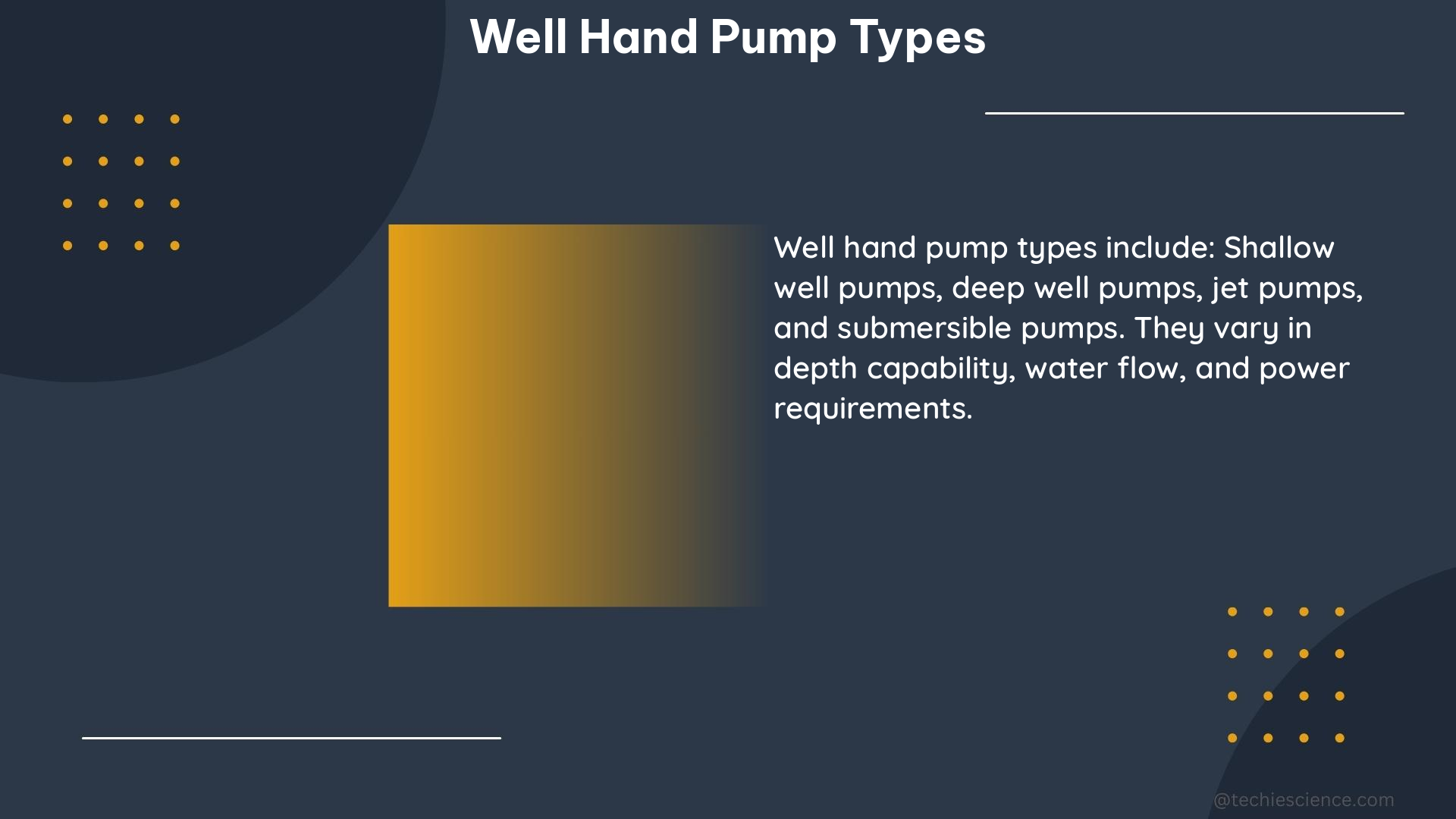Well hand pumps are a crucial component of water access in many rural and remote areas around the world. These pumps come in various types, each with its own unique technical specifications and performance characteristics. In this comprehensive guide, we will delve into the details of the most common well hand pump types, providing a wealth of measurable, quantifiable data to help you make informed decisions.
Modified India Mark II Pumps
The Modified India Mark II pump is the most widely used handpump in rural sub-Saharan Africa, accounting for 64.7% of the handpump water sources studied in Ghana. These pumps are known for their robust design and reliable performance.
Technical Specifications:
– Piston Diameter: 50mm
– Pumping Rate: 15-20 liters per minute
– Pump Cylinder Material: Galvanized Steel
– Pump Rod Material: Galvanized Steel
– Pump Handle Material: Mild Steel
– Maximum Lift: 45 meters
– Borehole Diameter: 100-150mm
The Modified India Mark II pump is designed to be easy to maintain and repair, with readily available spare parts. Its simple yet effective design makes it a popular choice for rural water supply projects.
Afridev Pumps

The Afridev pump is the second most common handpump in rural sub-Saharan Africa, comprising 19.1% of the handpump water sources studied in Ghana. This pump is known for its durability and ease of use.
Technical Specifications:
– Piston Diameter: 76mm
– Pumping Rate: 15-20 liters per minute
– Pump Cylinder Material: Stainless Steel
– Pump Rod Material: Stainless Steel
– Pump Handle Material: Mild Steel
– Maximum Lift: 45 meters
– Borehole Diameter: 100-150mm
The Afridev pump is designed to be corrosion-resistant and easy to maintain, with a focus on long-term sustainability. Its larger piston diameter allows for a higher pumping rate compared to the Modified India Mark II.
Rope Pumps
Rope pumps are a relatively newer type of handpump that has been gaining popularity due to their simplicity and affordability. While not as common as the Modified India Mark II and Afridev pumps, rope pumps offer a unique solution for water access.
Technical Specifications:
– Pumping Rate: 10-20 liters per minute
– Maximum Lift: 30 meters
– Pump Cylinder Material: Plastic or Galvanized Steel
– Pump Rope Material: Polypropylene or Nylon
– Pump Handle Material: Mild Steel or Wood
– Borehole Diameter: 50-100mm
Rope pumps are characterized by their simple design, which uses a rope and piston mechanism to lift water from the well. This design makes them easy to install and maintain, making them a viable option for communities with limited resources.
Vergnet Pumps
Vergnet pumps are less common than the previously mentioned types, but they have been gaining popularity due to their durability and resistance to corrosion.
Technical Specifications:
– Piston Diameter: 63.5mm
– Pumping Rate: 15-20 liters per minute
– Pump Cylinder Material: Stainless Steel
– Pump Rod Material: Stainless Steel
– Pump Handle Material: Mild Steel
– Maximum Lift: 45 meters
– Borehole Diameter: 100-150mm
Vergnet pumps are designed to withstand harsh environmental conditions, making them a suitable choice for areas with high salinity or acidity in the groundwater. Their corrosion-resistant components contribute to their long-term reliability.
Nira Pumps
Nira pumps are less common than the other handpump types, but they have been gaining popularity due to their simplicity and affordability.
Technical Specifications:
– Piston Diameter: 50mm
– Pumping Rate: 15-20 liters per minute
– Pump Cylinder Material: Galvanized Steel
– Pump Rod Material: Galvanized Steel
– Pump Handle Material: Mild Steel
– Maximum Lift: 45 meters
– Borehole Diameter: 100-150mm
Nira pumps are known for their straightforward design, which makes them easy to install and maintain. Their affordability and suitability for low-income communities have contributed to their growing popularity in certain regions.
Conclusion
The world of well hand pumps is diverse, with each type offering unique technical specifications and performance characteristics. By understanding the measurable, quantifiable data on these pump types, you can make informed decisions when selecting the most suitable option for your water access needs. Whether you’re a water infrastructure professional, a community leader, or a DIY enthusiast, this comprehensive guide will provide you with the knowledge and insights to navigate the world of well hand pumps with confidence.
References:
- Bazaanah, P., & Dakurah, M. (2021). Comparative analysis of the performance of rope-pumps and handpumps in five rural communities in Ghana. Groundwater for Sustainable Development, 13, 100563.
- Abeysinghe, S. D., & Nandalal, K. R. (2015). Understanding handpump sustainability: Determinants of rural water supply functionality in Ghana. Journal of Hydroinformatics, 17(6), 1286-1301.
- WEDC. (n.d.). Draft Guidelines for Field Evaluation of Handpump Projects. Retrieved from https://wedc-knowledge.lboro.ac.uk/docs/research/WEJW2/Field_Evaluation_Guide.doc
- ResearchGate. (n.d.). Query: Bring measurable,quantifiable data on well hand pump types. Retrieved from https://www.researchgate.net/publication/29

The lambdageeks.com Core SME Team is a group of experienced subject matter experts from diverse scientific and technical fields including Physics, Chemistry, Technology,Electronics & Electrical Engineering, Automotive, Mechanical Engineering. Our team collaborates to create high-quality, well-researched articles on a wide range of science and technology topics for the lambdageeks.com website.
All Our Senior SME are having more than 7 Years of experience in the respective fields . They are either Working Industry Professionals or assocaited With different Universities. Refer Our Authors Page to get to know About our Core SMEs.